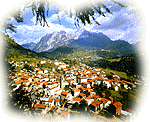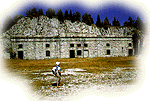 |

|
|
LOZZO DI CADORE |
|
| Lozzo (the name's origin is unclear) was founded in ancient times and colonized during the early Veneto period, according to archaeological finds unearthed last century. A Roman road was discovered not far from the church of the Madonna of Loreto. The earliest document in which the town is mentioned dates from 1188 and defines trade relations with the neighbouring Auronzo. The first church was built before 1226 and belonged to the parish of Vigo, from which is broke away in 1390. From the 14th to the 19th century Lozzo was administratively and militarily considered part of Domegge (as was also Vallesella). A fortified weir with towers and walls was built over the Piave River to improve the defence of the area. The town's history is filled with calamities such as the earthquake of 1348 and the fires of 1612, 1830 and 1867. Indeed, as a consequence of the repeated fires, the last of which burnt the whole town down, the old Cadore-type wooden houses are rare nowadays and most buildings are constructed in stone. Divided into two by a state highway, the town is a calm and serene place in a lower dale west of the Piave River near the opening of the Longiarin Valley. The traditional trades (agriculture, cattle breeding and forestry) have suffered a downturn while eyeglass manufacturing, with dozens of factories, and tourism are on the rise. The future of tourism in Lozzo rests on the appeal of Pian dei Buoi , a 1,800m-high plateau at the foot of the Marmarole Mountains, accessible to cars through a narrow paved road. It is an observation point affording a glorious panoramic view of the Cadore mountains and part of Carnia. Pian dei Buoi may serve as point of departure for various tours: to the Marmarole Lodging (1,786m), Ciareido Lodging (1,969m), Col Vidal (an area fortified during the First World War), Col Cervera, Chiggiato Lodging (1,911m) and Pian de Paradis.
|
||



 APT
APT